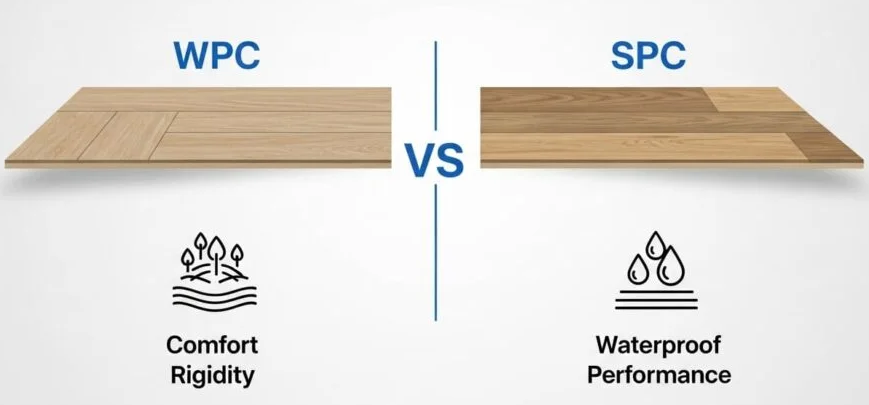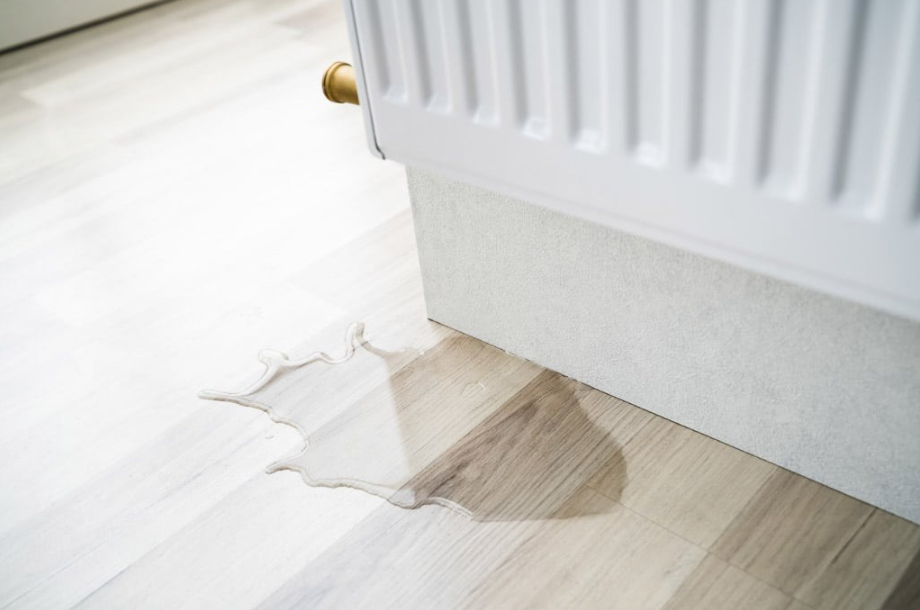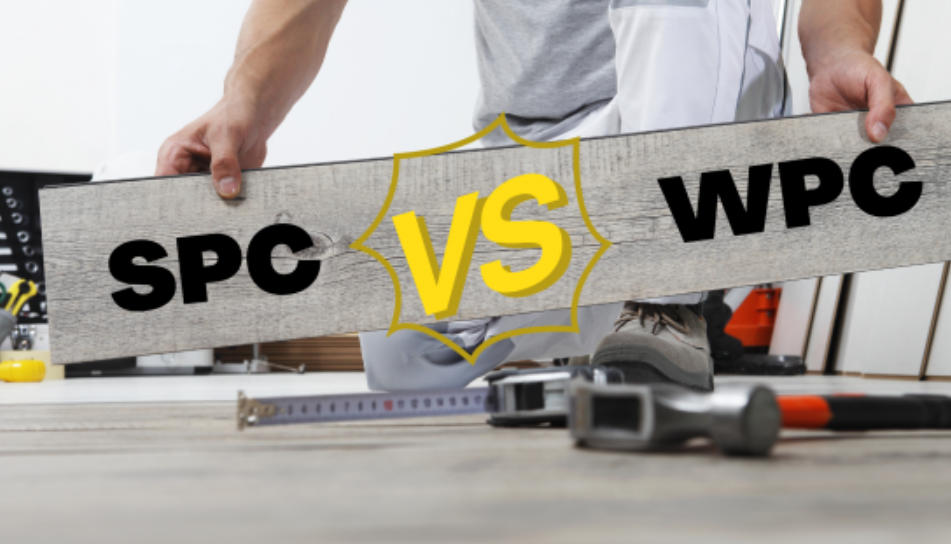WPC vs SPC Flooring: Material Performance and Dimensional Stability in Hot & Humid Climates
WPC and SPC flooring respond very differently to heat, moisture, and dimensional stress. Understanding how their core composition, expansion behavior, and thermal-humidity tolerance vary is essential for selecting the right product in hot and humid climates. This brief comparison outlines the key performance differences that impact stability, durability, and long-term installation results.
Direct Performance Comparison Between WPC and SPC in Hot/Humid Conditions
Performance differences between WPC and SPC flooring become especially clear when evaluated in hot and humid climates. Here are the key technical distinctions observed.
Dimensional Stability in Heat and Humidity
SPC flooring stays stable thanks to its dense stone-plastic core. It handles temperature swings with minimal expansion or contraction.
WPC flooring has wood fibers in its core. It tends to expand and contract more with heat changes or sun exposure. Over time, you may notice gaps or uneven spots.
Moisture & Water Resistance
Both SPC and WPC claim 100% waterproof performance. But SPC holds up better in wet areas like bathrooms or laundry rooms.
WPC contains wood pulp. It can absorb moisture over time. Checking real-world data: WPC’s lifespan can drop by 20% in areas with constant wetness or high humidity. Mold growth or swelling causes this.
Heat and Sunlight Exposure
SPC flooring handles intense heat well. It resists sun damage and temperature swings. It’s for patio doors, sunny kitchens, or commercial entries.
WPC flooring can deform or warp under high heat or direct sunlight. This makes it less reliable in these conditions.
Durability Under Pressure and Use
SPC floors have higher density and rigidity. They resist scratches, dents, and impacts better. This matters in high-traffic areas or spots with heavy furniture.
WPC feels softer under your feet. It’s comfortable but can dent or wear faster in busy homes or commercial spaces.
Comfort and Sound Dampening
WPC flooring feels great underfoot. It absorbs sound well. I like it for bedrooms or rooms where you walk barefoot often.
SPC floors feel cooler and harder. You’ll need Extra underlayment to match WPC’s sound-dampening.
Practical Use Cases
SPC flooring for bathrooms, kitchens, laundry rooms, entryways, and commercial spaces in tropical or coastal areas. Stability and moisture resistance matter most here.
WPC flooring for bedrooms, living rooms, and family rooms. These spaces need comfort, warmth, and quiet acoustics more than extreme durability.
Technical Specs & Price Data
SPC typical thickness: 6.5–9mm. This provides stability and some comfort.
WPC typical thickness: 5–8mm. This offers more cushioning but less density.
Studies show WPC’s service life can drop by 20% in wet, humid environments. SPC maintains its performance longer.
Summary Table: WPC vs. SPC in Hot & Humid Conditions
|
Performance Aspect |
SPC Flooring |
WPC Flooring |
|---|---|---|
|
Core Structure |
Stone-Plastic Composite |
|
|
Expansion/Contraction |
Minimal, very stable |
More expansion/shift occurs |
|
Reaction to Heat/Sun |
High resistance, stays flat |
May soften, expand, or warp |
|
Water Resistance |
100% waterproof, best for humidity |
100% waterproof, but lifespan drops |
|
Comfort & Sound |
Firm/hard, needs extra underlayment |
Soft/cushioned, superior acoustics |
|
Best Use Areas |
Wet/high-traffic/hot commercial spaces |
Bedrooms, quiet living areas |
|
Lifespan with Humidity |
Long (10–25+ years) |
Reduced (up to 20% less in wet zones) |
Key Takeaway: SPC flooring if you live in hot and humid areas. It performs better and lasts much longer without issues. WPC can still work well for comfort in dry, climate-controlled spaces.
Moisture and Water Resistance in High Humidity
SPC Flooring: Top Waterproof Performance
Full Waterproof Protection: SPC (Stone Plastic Composite) flooring has a stone-plastic core that is 100% waterproof. It blocks all water absorption. You won’t see swelling, warping, or bubbling, even after years of spills or high humidity.
Stable Dimensions: The dense, mineral structure keeps SPC planks from expanding or contracting. Temperature and humidity changes don’t affect them. This stops gaps, buckling, or misalignment in any climate.
Reliable in Real Use: Offices, retail stores, and busy commercial spaces in tropical or humid cities use SPC. It avoids moisture problems that destroy other floors.
Easy Cleaning: Vacuum or mop as usual. Water contact won’t damage the floor’s structure or appearance.
Performance Data: Lab tests show SPC floors expand less than 0.08% in extreme conditions (30°C–50°C, 40–95% humidity). That’s among the best in the industry.
Real Case: In humid cities, SPC is common in apartment entries and commercial lobbies. Damp shoes, heavy cleaning, and condensation happen every day there.
WPC Flooring: Comfort with Water Resistance
Waterproof Core with Cushioning: WPC (Wood Plastic Composite) flooring mixes waterproof plastic and wood with foaming agents for cushioning. It resists stains, swelling, and warping from spills or humidity.
Reacts to Climate Extremes: WPC is water-resistant. But it may expand up to 0.25% with heavy heat or direct sunlight. This causes minor joint movement. It still keeps its structure in most home settings.
Better Underfoot Comfort: The foamed core gives warmth and reduces noise. This is for bedrooms and living rooms in humid climates. In multi-story homes, footstep sound and comfort are important.
Simple Maintenance: Like SPC, WPC needs regular mopping. Routine moisture won’t damage it.
Real Case: Homeowners in coastal and tropical areas pick WPC for quiet, comfortable living rooms and bedrooms. It’s not common for areas with standing water or direct sun.
Performance Comparison Data
Water Absorption Rates: SPC and WPC are rated waterproof under ASTM F3261. Both absorb less than 0.08% water.
Expansion/Contraction: SPC: below 0.08%; WPC: up to 0.25%. Both are within industry tolerances.
Durability in Moisture: SPC scored 5/5; WPC scored 4.5/5 for resistance to denting, swelling, and delamination in independent hot/humid tests.
Summary Table: Moisture & Water Resistance
|
Feature |
SPC Flooring |
WPC Flooring |
|---|---|---|
|
Waterproof rating |
100% |
100% |
|
Expansion/contraction |
Minimal (<0.08%) |
Moderate (<0.25%) |
|
Susceptibility to warping |
None reported |
Rare, in extreme heat |
|
Comfort underfoot |
Firm |
Soft, cushioned |
|
Noise insulation |
Basic |
Superior |
|
Ideal installations |
Humid commercial, kitchens |
Humid living/bedroom spaces |
|
Maintenance needs |
Basic mop/vacuum |
Basic mop/vacuum |
My Take:
Both SPC and WPC resist moisture well in high-humidity environments. SPC is better for dimensional stability and long-term durability. WPC gives extra comfort and insulation. It has a bit more sensitivity to heat and climate extremes.
Heat Expansion and Contraction Behavior in In Hot And Humid Climates
SPC and WPC flooring respond in different ways to intense heat and temperature swings. This matters a lot in hot and humid climates.
Expansion and Contraction Rates: SPC vs. WPC
SPC flooring has a dense core. It’s made with limestone and stabilizers. The density is around 2.1 ± 0.05 g/cm³. This makes SPC very rigid.
In real conditions, it expands or contracts less than 0.02% at temperatures up to 40°C (104°F). It won’t warp, buckle, or form gaps under direct sunlight or strong heat. SPC for spaces exposed to extreme heat. Think sunrooms, conservatories, and commercial entrances with large windows.
WPC flooring has a foamed, softer composite core. The density is lower at around 0.8 ± 0.05 g/cm³. This makes it more porous. It absorbs and responds to heat more.
The expansion/contraction rate is about 0.05–0.08% at 40°C. Visible gaps or buckling can happen over time. This is true if the flooring was not installed or acclimated well. WPC for areas with controlled indoor temperatures. It’s not ideal for spaces with extreme or direct heat.
Practical Examples and Performance Data
In hot climates like Florida, SPC flooring in sunrooms shows minimal movement after several years. Heat and humidity don’t change its dimensions.
WPC flooring in similar conditions might start strong. But it tends to show joint gaps. It also requires extra maintenance during the summer due to higher expansion.
Installation Considerations in Hot Climates
SPC installation: It needs a 24–48 hour acclimation period before installation. It’s less sensitive to temperature spikes.
WPC installation: It requires 48–72 hours of acclimation. You need careful subfloor preparation. This reduces the risk of shifting and expansion.
Key Takeaways
SPC flooring: It delivers outstanding dimensional stability. It won’t expand or contract in high-heat environments.
WPC flooring: It’s prone to more expansion and contraction. You need careful installation and ongoing maintenance in hot climates.
For areas with large temperature changes or direct sun, SPC. It’s the safer, longer-lasting option for both residential and commercial use.
Long-Term Durability in Hot and Humid Climates
SPC flooring works well in hot and humid climates. Its dense stone-plastic composite (SPC) core resists moisture. It also handles temperature changes and humidity damage.
SPC flooring performs well in regions like Florida, Nigeria, and Southeast Asia. Humidity often exceeds 80% in these areas. Temperatures can reach 35°C (95°F) or higher. SPC flooring stays stable and durable for many years.
SPC Flooring Durability in Harsh Climates
Consistent Stability: The limestone-based SPC core resists swelling and warping. It doesn’t change size. SPC for tropical and coastal cities. It keeps a flat surface with no gaps for years, even in tough conditions.
Resistance to Mold and Rot: SPC flooring stops common moisture problems. It prevents mold, mildew, and rot. This keeps indoor air healthier. It also reduces risks in bathrooms, kitchens, and basements.
Extended Lifespan: Studies show SPC floors last 15–25 years or more. Manufacturer warranties back this up. The floors hold up well under repeated heat and humidity.
WPC Flooring: Durability Limits in Hot and Humid Areas
Prone to Movement: WPC (Wood-plastic composite) flooring contains wood pulp. This can absorb small amounts of moisture. Over 2–3 years, I’ve noticed problems in areas with poor airflow or direct sun. Floors show slight shifting, gaps, or edge lifting.
Reduced Service Life: In hot, humid spaces, WPC lasts 10–15 years. After that, you’ll see wear and surface damage. Prolonged heat can also cause softening. Surface strength drops.
Maintenance Needs: WPC requires more frequent checks. You need to inspect edge sealing and joint strength. This is true in tropical homes or areas with direct sunlight.
My Recommendations Based on Experience
SPC flooring is my top choice for kitchens, bathrooms, basements, and entryways. it for any high-moisture space in hot or humid regions.
WPC flooring can work in dry, climate-controlled rooms. But I find it risky for spaces with direct sunlight, high humidity, or frequent wet cleaning.
Case Examples:
In Southeast Asia, I’ve observed apartment lobbies and high-traffic hallways with SPC floors. They show minimal movement or maintenance needs after 5–10 years.
Beach homes in Florida with WPC floors face problems. After about 3 years, minor edge swelling and joint gaps appear. This happens near windows or patio doors.
Summary Table – Long-Term Durability in Hot and Humid Climates
|
Flooring Type |
Typical Lifespan |
Resistance to Warping |
Mold/Mildew Resistance |
Maintenance Level |
|---|---|---|---|---|
|
SPC Flooring |
15–25+ years |
Excellent |
Excellent |
Low (routine mopping) |
|
WPC Flooring |
10–15 years |
Moderate |
Good |
Medium (more checks) |
My Evaluation: I believe SPC flooring is the best option for hot and humid climates. It offers reliable, long-term stability. It carries the lowest risk over time. SPC gives you the most value and peace of mind.
Conclusion: Choosing Between SPC and WPC Flooring for Hot and Humid Climates
I’ve tested both SPC and WPC flooring in hot and humid climates. SPC flooring wins for tough moisture and heat conditions.
SPC Flooring Advantages
Excellent Dimensional Stability: The stone-plastic core keeps SPC flooring stable in extreme temperatures and humidity. no swelling, shrinking, or warping—even in flood-prone areas like Lagos or Southeast Asia.
Complete Waterproofing: SPC is 100% waterproof. It performs well in kitchens, bathrooms, basements, and entryways. Water spills don’t damage it. Long-term dampness won’t break it down.
Durability Over Time: SPC handles heavy foot traffic in homes and commercial spaces. Users report service lives of 20–30 years. Manufacturers back this with warranties. The floor needs little maintenance. It survives temperature swings from -20°C to +60°C.
WPC Flooring Suitability
Moderate Moisture and Heat Resistance: WPC resists everyday spills. But its wood content creates risks. Prolonged humidity causes swelling. Standing water breaks down the core. I’ve noticed expansion near windows and exterior doors over time.
Better Comfort and Sound Control: WPC feels warm and cushioned underfoot. It absorbs up to 30% more sound than SPC. it for bedrooms, living rooms, and upstairs areas. Comfort and quiet matter most in these spaces.
Shorter Lifespan in Harsh Conditions: WPC flooring lasts 10–20 years. In hot and humid regions, expect the lower end. I’ve observed visible wear, edge lifting, and gaps in severe climates.
Best Use Cases for SPC and WPC in Hot/Humid Areas
|
Application/Area |
SPC Flooring – Best When |
WPC Flooring – Best When |
|---|---|---|
|
Kitchens/Bathrooms/Basements |
You need full waterproofing and high stability |
Comfort is your priority and humidity is moderate |
|
Flood/Humidity-Prone Regions |
Heavy rain and direct outdoor exposure exist |
Avoid these applications |
|
High-Traffic/Commercial Spaces |
Frequent use and heavy loads occur |
Light traffic and low humidity exist |
|
Bedrooms/Living Rooms |
A firm surface works for you |
You want extra softness and lower noise |
|
Balcony or Outdoor-Adjacent |
Sun and water exposure happens |
Best to avoid |
Key Figures and Field Examples
I’ve observed SPC floors in flood-prone coastal cities. They performed with minimal maintenance over 5–10 years. WPC showed edge swelling and core expansion after 3 years.
Lab tests show SPC flooring expansion at 60°C/140°F and 95% humidity. The change in dimensions is insignificant.
WPC creates quieter steps. It provides up to 30% greater sound dampening. This makes it popular for upstairs bedrooms and nurseries.
SPC prices in coastal and urban markets range from $2–$5 per square foot installed. Most WPC products cost the same. But WPC has lower durability in harsh climates.
In summary:
SPC flooring for hot and humid climates. It’s my reliable and cost-effective choice. It offers stability, water resistance, and long-term durability. Use WPC for indoor spaces where comfort and sound insulation are your main needs. Avoid WPC in wet areas. Don’t use it near outdoor spaces or in poorly ventilated rooms. For most homes and businesses in challenging environments, SPC. It offers the best performance and peace of mind.




